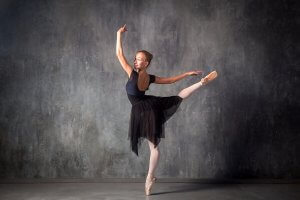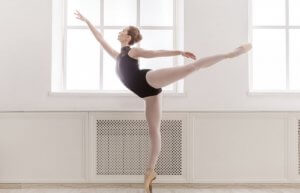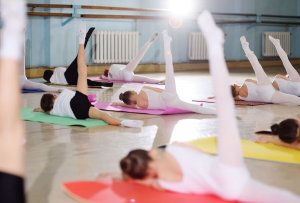Physical Traits Developed by Classical Dance

Classical dance is an artistic activity that involves expressing feelings and telling stories through the movements of the body. Beyond the gestures performed by the dancers, they must also prepare their bodies to perform the choreography.
Likewise, classical ballet is made up of exercises and postures that challenge human anatomy. Therefore, as time passes and dancers expand their range of movements, they also start to undergo physical changes.
Physical changes produced by classical dance
1. Weight loss
Dancing is a form of aerobic exercise, which means that it’s vigorous enough to raise the heart and respiratory rates. And if you do it regularly, it can help you lose as much weight as other forms of exercise.
Classical dance is full of cardiovascular exercises that help the dancer increase their resistance. According to professional dancer Barbara Craddock, “Ballet can burn more calories than other forms of dance, such as salsa or ballroom dancing.”
2. Increased strength in the feet
Dancers must work-out all the areas of their bodies to perform the movements and postures necessary to dance. The feet, because of the positions and footwear are among the extremities that require a lot of strength.

Postures such as relevé, which require dancers to rise up and seemingly stand “on their toes,” along with other aspects, modify the appearance of their feet.
In this way, a dancer’s feet can acquire a lot of strength, flexibility, and agility; but on the other hand, bunions may develop, blisters will appear, and there may be wear on the bones, swelling, claw toes, pain in the plantar arch, sesamoiditis, or metatarsalgia.
3. Posture
According to professional dancer and performance coach Christina Chitwood, dance exercises the muscles and fibers that control posture. Therefore, while dancing, the muscles located around the spine contract to maintain posture.
Dancers must become used to maintaining difficult positions despite the fatigue that may occasionally arise. This sometimes results in a slight stooping, even when dancing is not training.
Typical classical ballet poses stimulate the inner muscles (stomach and back), as well as the muscles that surround the spine. As dancers train, they improve their posture and increase muscle tone.
4. Balance and coordination, the keys to classical dance
All forms of dance enhance balance and coordination, although some more than others. In the case of classical dance, dancers are required to maintain their balance to ensure that they don’t lose their footing when spinning.
Dancing improves proprioception and psychomotor development. Pas de deux, pas de trois or group dancing depends, to a great extent, on coordination, since all dancers must be in tune with each other for the performance to work.
5. Strong, well-toned muscles
Dancing is especially good for the leg and glute muscles. It also works the hips, arms, lower back, and abdomen. As muscle tone improves and flexibility increases, dancers experience relief from back pain and gain resistance.

However, sometimes so much is demanded of ballet dancers that it can result in stiffness, muscle dystrophy, and injuries. Therefore, dancers must become used to dealing with constant ailments despite reaping the benefits already mentioned, such as greater strength and muscle tone.
Classical dance as a sport
Throughout its history, classical ballet has demanded more of its dancer’s physical abilities; today, classical dance artists are expected to perform well, physically, and artistically.
In this way, classical dance can be considered an art form that also explores the sports world; mainly because of all the exercises that the dancers must perform and the physical state they must achieve to dance.
Classical ballet is an elite discipline that requires perseverance, courage, love, and perseverance to perform excellently. But, it takes a lot of patience to cope with the changes it can cause to the human body.
Classical dance is an artistic activity that involves expressing feelings and telling stories through the movements of the body. Beyond the gestures performed by the dancers, they must also prepare their bodies to perform the choreography.
Likewise, classical ballet is made up of exercises and postures that challenge human anatomy. Therefore, as time passes and dancers expand their range of movements, they also start to undergo physical changes.
Physical changes produced by classical dance
1. Weight loss
Dancing is a form of aerobic exercise, which means that it’s vigorous enough to raise the heart and respiratory rates. And if you do it regularly, it can help you lose as much weight as other forms of exercise.
Classical dance is full of cardiovascular exercises that help the dancer increase their resistance. According to professional dancer Barbara Craddock, “Ballet can burn more calories than other forms of dance, such as salsa or ballroom dancing.”
2. Increased strength in the feet
Dancers must work-out all the areas of their bodies to perform the movements and postures necessary to dance. The feet, because of the positions and footwear are among the extremities that require a lot of strength.

Postures such as relevé, which require dancers to rise up and seemingly stand “on their toes,” along with other aspects, modify the appearance of their feet.
In this way, a dancer’s feet can acquire a lot of strength, flexibility, and agility; but on the other hand, bunions may develop, blisters will appear, and there may be wear on the bones, swelling, claw toes, pain in the plantar arch, sesamoiditis, or metatarsalgia.
3. Posture
According to professional dancer and performance coach Christina Chitwood, dance exercises the muscles and fibers that control posture. Therefore, while dancing, the muscles located around the spine contract to maintain posture.
Dancers must become used to maintaining difficult positions despite the fatigue that may occasionally arise. This sometimes results in a slight stooping, even when dancing is not training.
Typical classical ballet poses stimulate the inner muscles (stomach and back), as well as the muscles that surround the spine. As dancers train, they improve their posture and increase muscle tone.
4. Balance and coordination, the keys to classical dance
All forms of dance enhance balance and coordination, although some more than others. In the case of classical dance, dancers are required to maintain their balance to ensure that they don’t lose their footing when spinning.
Dancing improves proprioception and psychomotor development. Pas de deux, pas de trois or group dancing depends, to a great extent, on coordination, since all dancers must be in tune with each other for the performance to work.
5. Strong, well-toned muscles
Dancing is especially good for the leg and glute muscles. It also works the hips, arms, lower back, and abdomen. As muscle tone improves and flexibility increases, dancers experience relief from back pain and gain resistance.

However, sometimes so much is demanded of ballet dancers that it can result in stiffness, muscle dystrophy, and injuries. Therefore, dancers must become used to dealing with constant ailments despite reaping the benefits already mentioned, such as greater strength and muscle tone.
Classical dance as a sport
Throughout its history, classical ballet has demanded more of its dancer’s physical abilities; today, classical dance artists are expected to perform well, physically, and artistically.
In this way, classical dance can be considered an art form that also explores the sports world; mainly because of all the exercises that the dancers must perform and the physical state they must achieve to dance.
Classical ballet is an elite discipline that requires perseverance, courage, love, and perseverance to perform excellently. But, it takes a lot of patience to cope with the changes it can cause to the human body.
All cited sources were thoroughly reviewed by our team to ensure their quality, reliability, currency, and validity. The bibliography of this article was considered reliable and of academic or scientific accuracy.
- Christina Chitwood’s Performance; Top 5 Ways Dance Improves Performance in Everyday Life; Agosto 2010.
- Dancescape; Benefits of Dancing & Quick Tips for Staying Healthy; Barbara Craddock; Abril 2006.
- University of Galicia: Posture
- Ed Yong. 2009. Ballet postures have become more extreme over time.
This text is provided for informational purposes only and does not replace consultation with a professional. If in doubt, consult your specialist.








